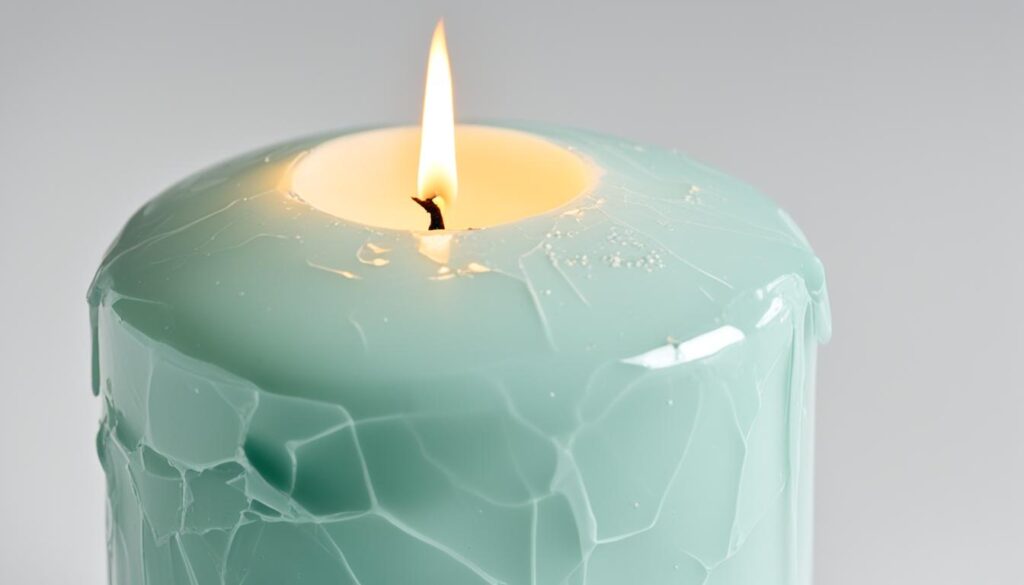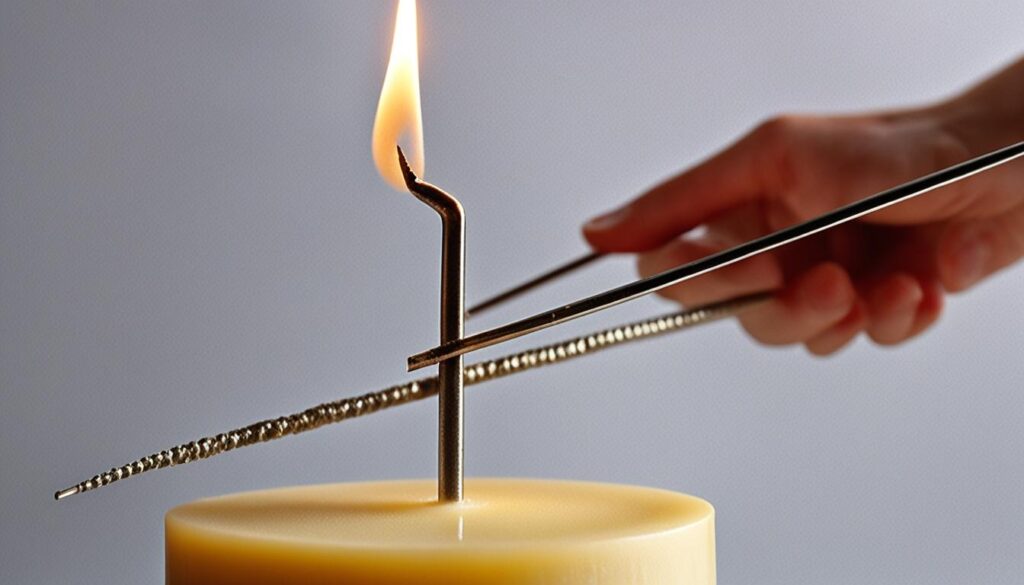The Science Behind Candle Making: Tips for Success
Candle making combines art and science beautifully. Ever wondered what makes a candle burn so captivating? Or how to make amazing candles at home? Learning the science behind candle making can help you become a skilled DIY candlemaker.
Making your own candles is fulfilling. It lets you express your creativity and use chemistry and physics. By understanding the basics and advanced techniques, you can improve your candle-making skills. This will help you get professional-quality results.
Key Takeaways
- Candle making is a blend of art and science, with an understanding of chemistry and physics being crucial
- Mastering the basic steps, including melting wax, adding scents and dyes, and properly wicking and pouring, is essential for success
- Exploring the science behind candle burning, fragrance selection, and troubleshooting common issues can help you create exceptional candles
- Proper temperature control, curing, and aging techniques can elevate your candle-making skills to the next level
- Understanding safety considerations and incorporating effective branding and marketing strategies can make your handmade candles stand out
Understanding the Fundamentals of Candle Making
Starting with candle making tutorials and candle making instructions means learning the basic steps of the DIY candle making process. You’ll need to know how to melt wax and pour it into containers. Each step is important for getting the look and smell you want.
The Basic Steps
Here are the key steps to make your own candles:
- Melt the wax to the right temperature
- Add fragrance oils or dyes
- Put the wick in the containers or molds
- Pour the wax mixture into the containers
- Let the candles cool, set, and cure
The Art and Science of DIY Candles
Candle making is more than just a simple task; it’s a mix of art and science. To make amazing DIY candles, you need to know about wax, wicks, and fragrances.
“Candle making is a delicate balance of science and creativity, where each decision can impact the final outcome.”
Learning the science behind candle making helps you make candles that burn well, smell great, and look good. But don’t forget the artistic side. This is where you can make your candles unique and personal.
Whether you’re just starting or you’ve been making candles for a while, understanding the basics is crucial. By combining science and art, you can make candles that are not just beautiful but also tell your story.
Mastering the Techniques
Making candles that look great and last long takes a lot of knowledge. You need to know about the candle wax types, their wax properties, and the right wick size. With this knowledge, you can make candles that look beautiful and smell great.
Choosing the Right Wax
Soy wax is a top pick for candle makers. It has a low melting point and doesn’t produce much soot. This makes it safe and eco-friendly. On the other hand, paraffin wax gives a strong fragrance throw but can release harmful fumes when burning.
Selecting the Ideal Wick Size
Choosing the right wick size is key to making great candles. The wick must match the wax type and the candle’s size. A well-matched wick ensures a clean, even burn. The wrong size can lead to uneven melting or dangerous flare-ups.
| Wax Type | Melting Point | Fragrance Throw | Soot Production |
|---|---|---|---|
| Soy Wax | 120-135°F | Medium | Low |
| Paraffin Wax | 135-145°F | High | High |
Learning to pick the right types of candle wax and wick size is crucial. It helps you make candles that look good, smell nice, and burn safely. With these skills, your candle-making will be exciting and rewarding.
Enhancing Your Candle’s Aroma
Making a candle smell great is all about balance. You need to pick the right candle fragrance oils and make sure they fill the air well. This makes the experience of lighting your candle special.
Selecting Fragrance Oils for Candle Making
Not all fragrance oils are the same. Some are strong, so a little goes a long way. Others need more to smell as good. Always choose oils made for candle making. They can handle the heat and keep their smell.
Optimizing Fragrance Throw
Getting your candles to smell better can really change the game. Try different amounts of oil, temperatures, and waiting times. This helps you find the best mix for a strong, lasting scent. By getting good at this, you can make your candles stand out. They’ll grab the attention of everyone who smells them.
“The right fragrance can transport you to a different time and place, evoking emotions and memories. Candle making is an art that allows you to craft these sensory experiences.”
Troubleshooting Common Candle Making Issues
Making the perfect candle is an art. Even experts face challenges. Issues like uneven cooling and the “tunneling” effect can happen. Knowing why and how to fix these candle making problems is key to making great candles.
“Wet spots” on the candle surface are common. They come from not curing the wax right or overheating it when pouring. Fix this by adjusting the pour temperature and letting the candle cool slowly.
Tunneling, where the wax burns down the middle, is another issue. It’s often from a wrong-sized wick or the wick being too low. Try different wick types and positions to resolve candle issues and get an even burn.
Uneven surfaces or “hills and valleys” can also happen. This can be fixed by controlling the temperature and pour method. Using fans or chilling plates can also help.
By knowing how to fix these candle troubleshooting issues, makers can make high-quality candles. These candles will please their customers.

| Common Candle Making Issues | Possible Causes | Troubleshooting Tips |
|---|---|---|
| Uneven Wax Cooling | – Improper pouring technique – Sudden temperature changes |
– Adjust pour temperature – Use specialized cooling methods (fans, chilling plates) |
| “Wet Spots” on Surface | – Improper curing – Overheating wax during pouring |
– Adjust pour temperature – Allow candle to cool slowly and evenly |
| Tunneling Effect | – Incorrectly sized wick – Wick positioned too low in container |
– Experiment with different wick types and placements – Ensure proper wick positioning |
science of candle making: Understanding Candle Chemistry
Exploring candle making reveals a world full of candle chemistry. This science is about how candles are made and burn. It’s a mix of elements that work together to create the final product. From wax melting and solidifying to the wick burning, it’s all about chemistry.
The core of candle making is changing solid wax into a liquid and then back to solid. Heat does this by breaking the wax molecules. This creates a liquid wax pool around the wick, which feeds the flame.
The burning of the wick is complex. It involves oxygen, fuel, and heat. The wick helps the wax vaporize and mix with air, creating a flammable mix. This mix ignites, producing the flame we see.
Knowing about candle chemistry helps candle makers improve their craft. By understanding the science, they can fine-tune their wax, wick, and burning techniques. This leads to better candles in terms of look, smell, and performance.
“The science of candle making is a dance between art and chemistry, where the interplay of elements creates a mesmerizing and captivating experience.”
Whether you’re experienced or new to candle making, learning about the science behind candles can deepen your appreciation. It can also inspire you to try new things in making handmade candles.
Preventing Tunneling and Achieving an Even Burn
Creating candles that burn evenly is key to a great experience. Candle makers often struggle with the “tunneling” effect, where the wax burns down the middle, leaving the edges thick and unburned. By focusing on wicking and the candle poking technique, you can stop this and make sure your candles burn evenly.
The Importance of Wicking
The wick is crucial in the burning process, pulling the melted wax to the flame. It’s important to anchor the wick right to stop it from leaning or sinking into the wax. This can cause uneven burning and tunnels. Try different wick sizes to find the best fit for your candle’s size and wax type.
The Candle Poking Technique
To stop candle tunneling, try the poking technique. Use a wick trimmer or tool to poke and mix the wax pool now and then. This helps get rid of air pockets and spreads the wax evenly. Doing this can greatly improve the consistent, even burn of your candle.
| Technique | Benefits |
|---|---|
| Proper Wicking | Ensures the wick is properly anchored and draws wax effectively, preventing tunneling. |
| Candle Poking | Helps eliminate air pockets and distribute the wax evenly for a consistent burn. |

Mastering these techniques can take your candle-making to the next level. You’ll make candles that are captivating, long-lasting, and leave a strong impression.
Candle Making Tips for Beginners
Starting your candle making journey can be thrilling and rewarding. But, it’s normal to feel a bit lost at first. Don’t worry! We’ve put together some key candle making tips for beginners to boost your confidence.
Don’t worry if your first candles don’t look perfect. Candle making is an art that requires time and practice. See each try as a chance to learn and get better.
Before starting, clean your candle containers with soapy water. This step ensures a clean surface for your candles. Also, keeping a candle-making journal is very helpful. It lets you track your progress, note your experiments, and learn from mistakes.
When you start, avoid adding too many extra things. Focus on the basics: wax, wick, and fragrance. Mastering these will give you a strong foundation before you try more complex techniques.
The journey of candle making for beginners is about learning and growing. Embrace the challenges, celebrate your wins, and keep learning. With these tips, you’re set to become a skilled candle maker.
Advanced Techniques for Experienced Candle Makers
As you dive deeper into the world of candle making, exploring advanced techniques can take your craft to new heights. Mastering temperature control and perfecting the curing and aging process are key for experienced candle makers. These steps help improve the quality and performance of your creations.
Temperature Control
Keeping a precise temperature during the candle-making process is crucial for great results. You need to preheat the glassware and control the cooling process carefully. This ensures the wax melts and cools at the right temperatures. Using top-quality equipment and learning how to regulate temperature can greatly improve your candles’ look, smell, and burn quality.
Curing and Aging
The curing and aging process is often overlooked but is crucial. Letting your candles cure and age properly boosts their quality and performance. This step lets the fragrance fully develop and the wax settle, leading to a more even burn. Using advanced candle making techniques like strategic curing and aging can make your candles stand out.
Adopting these temperature control and candle curing and aging methods will elevate your craftsmanship. It ensures your candles are in high demand and your business thrives. Keep exploring and refining your advanced candle making techniques to stay ahead.
Branding and Marketing Your Handmade Candles
Creating a strong brand identity is key to marketing your candle business well. This means picking a catchy business name, having a consistent color scheme and logo, and making your candle labels look good. By making your brand personal and authentic, you can stand out and connect with your customers.
Developing a Unique Brand Identity
Building a strong brand identity for your handmade candles takes thought. Begin by thinking of a unique business name that speaks to your customers. Pick a name that shows what your candle brand is all about and grabs their interest.
Then, work on your brand’s look. This includes picking colors, designing a logo, and making custom labels. Make sure your brand looks the same everywhere, from your website to your packaging.
To market your candle brand well, add personal touches. Talk about how you make your candles and the special ingredients you use. Emphasize the care you put into each candle.
Remember, a real and memorable brand identity helps you stand out. By putting effort into developing your candle brand, you can gain loyal customers and set your products up for success.
Safety Considerations in Candle Making
Making your own candles can be fun and rewarding. But, it’s important to keep safety in mind. Here are some key steps to make sure you enjoy your candles safely.
First, think about the materials you use. Don’t add things like dried flowers or rocks that could catch fire. Also, be careful with substances that can release harmful fumes when they burn.
Where you place your candles is also crucial. Keep them away from things that can catch fire, like curtains or furniture. Make sure they’re out of reach of kids and pets. And always trim the wick before lighting to avoid big flames and soot.
When you need to put out your candles, don’t blow them out. This can make hot wax splatter. Instead, use a wick dipper or candle snuffer to put out the flame safely.
By following these safety precautions in candle crafting, you can enjoy your candles safely. These steps help you avoid candle making safety issues. This way, you can make candles that look great and are safe for everyone.
“The safety of your home and loved ones should always come first when crafting candles.”
| Safety Tip | Importance |
|---|---|
| Avoid adding hazardous materials | Mitigates fire risks and potential health hazards |
| Proper candle placement | Prevents accidental fires and keeps candles out of reach |
| Trim wick to recommended length | Reduces excessive flame and soot buildup |
| Use a wick dipper or candle snuffer | Safely extinguishes the flame without splattering hot wax |
Conclusion
The art of candle making is a fascinating journey with many possibilities. By learning the basics, improving your skills, and solving common problems, you can make amazing candles. These candles will delight and enchant everyone who sees them.
You’ve learned how important it is to know about candle chemistry, improve wicking, and control temperatures. These tips will help you make candles that burn well, keep their scent, and are safe to use. This will make your candles a hit with everyone.
Being a candle maker means always learning, trying new things, and getting better at what you do. With passion, patience, and a keen eye for detail, you can improve your candle-making skills. You’ll be able to add warmth, beauty, and a special touch to any room. The world of candle making is full of chances to explore, create, and make a lasting impact.
FAQ
What are the basic steps to make candles?
Is candle making just a simple process or is it an art and science?
What are the different types of wax commonly used for candle making?
How important is the choice of fragrance oils for scented candles?
What are some common issues candle makers may face during the candle-making process?
What is the science behind the burning of a candle?
How can candle makers prevent the “tunneling” effect in their candles?
What are some essential tips for beginners in candle making?
What are some advanced techniques experienced candle makers can explore?
Why is establishing a strong brand identity important for selling handmade candles?
What safety considerations should candle makers keep in mind?
Source Links
- https://kalamazoocandle.com/blogs/learn-about-candles/candle-making-tips-tricks – 15 Candle Making Tips and Tricks (For Beginners)
- https://www.candlescience.com/learn-candle-making/ – Learn how to make candles
- https://www.candlescience.com/starting-your-own-candle-business-a-blueprint-for-success/ – Starting Your Own Candle Making Business: A Blueprint for Success
- Fragrance That Wows: A Beginner’s Guide to Adding Scents to Your Homemade Candles
- best essential oils for candles
- wood wick guide
- how to make candles smell stronger
- how to ship candles
- how to fix soy wax frosting
- wick Guide how to choose the right wick size with chart
- how to make candle molds
- how to clean candle wax
- how to reuse candle jars
- soy wax candle troubleshooting
- best wax melter for candle making
- how to conduct burn test
- why candle flickering crackling smoking
- how much wax per candle
- how to make candles smell stronger
- Easy Ways to Increase the Scent Throw of Your DIY Candles
- How to Make Candles for Meditation and Relaxation
- Using Upcycled Materials in Candle Making
- How to Make Hand-Poured Candles: Tips and Techniques

Leave a Reply